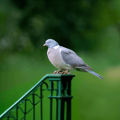As an expert in the domain of bird poop cleaning, I can provide you with valuable information about the characteristics of bird droppings. One common question that many bird owners have is whether bird poop is always wet. Let’s explore this topic to help you understand what is considered normal and what may indicate a health problem in your bird.
Healthy bird droppings can display an array of colors and still be considered “normal.” This is because birds consume various types of fresh fruits, vegetables, seeds, and pellets. The food dyes in these pellets, combined with the natural colors of the foods they eat, contribute to the diverse colors in their droppings. So, don’t be alarmed if you see different shades in your bird’s poop.
However, sudden changes in color can indicate severe health problems that require prompt veterinary attention. If you notice such changes, it is important to seek professional help for your bird.
The texture of bird droppings can vary depending on their diet. Ideally, the consistency should be similar to toothpaste, neither too wet nor too dry. Droppings that are very dark or appear “tarry” may indicate internal bleeding, which requires immediate veterinary care. Monitoring the texture of your bird’s droppings will help you determine if they are healthy or if there is a potential health issue.
In general, a healthy bird’s droppings should produce little to no odor. If you notice a strong or unpleasant smell, it could be a sign of infection, intestinal problems, or other illnesses. While it is not recommended to directly smell your bird’s droppings due to potential health risks, paying attention to any noticeable scent when your bird uses the bathroom can help you identify if something is not right. If you suspect an unusual odor, it is advisable to contact your bird’s vet for an evaluation.
Unlike mammals and other animals, bird droppings are not normally solid. A healthy bird’s waste will contain a fair amount of liquid because they do not have a separate mechanism for eliminating liquid waste from their bodies. The urine in bird droppings usually appears as a white-colored, pasty liquid, comprising around 30 to 50 percent of the volume of the droppings. While slight variations in the amount of liquid are normal, if you notice an excessive or insufficient amount, it is important to consult your avian veterinarian.
The volume of a bird’s droppings is relative to the size of the bird. Smaller birds will produce smaller droppings, while larger birds will produce larger ones. It is normal for the frequency and amount of droppings to vary slightly depending on their diet. However, any drastic change in size or frequency should be noted and reported to your veterinarian. If you want to monitor your bird’s poop frequency, you can add a blueberry to their diet. The blue color will help you measure how long it takes for a blue poop to result after feeding.
By paying attention to your bird’s droppings and understanding what falls within the normal range for your particular bird, you can better assess their health.
If you need professional bird poop cleaning services, contact Bird Poop Cleaning at [email protected] or call us at [082-797-3702]. We specialize in sanitizing, disinfecting, removing, and cleaning bird poop, droppings, eggs, birds, chicks, and nests from balconies, homes, storage areas, and factories in Bangkok. Our expert team will ensure that your living or working space is free from any bird-related mess.
Choose how you'd like to reach us:
